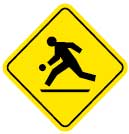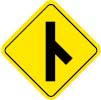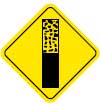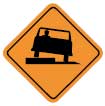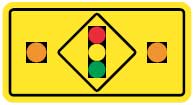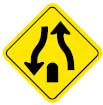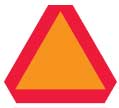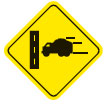Notice
This is the non-interactive basic mode of Alberta Driver’s Licence Class-5/7 GDL Quiz questions database for printing or use in case of SQL database failure on main site. All the questions and answers are identical except the order of questions and answers.Please use the interactive version for more up to date materials.
1. To become fully licensed, a driver must be….(choose more than one answer) (ID-GDL-01)
A. have been suspension free for the last 12 months.
B. at least 21 years of age.
C. pass the advanced road test.
D. at least 18 years of age.
E. have been suspension free for the last 16 months.
2. What is the minimum age requirement for Alberta Class 5 GDL license? (ID-GDL-02)
A. 21
B. 18
C. 14
D. 15
E. 16
Question 2 Explanation: Class 7-GDL is issued for drivers between 14 and 16 years of age.
3. The electronic driver’s knowledge test is based on “Driver’s Guide” booklet. The test is only administered in English medium. (ID-GDL-03)
A. False
B. True
Question 3 Explanation: The exam can be taken in French and several other languages.
4. What type of vehicles a Class-5 license holder can operate? (ID-GDL-04)
A. Four-axles vehicles, passenger vehicles with more than four people, recreation vehicles with not more than five axles, mopeds, trailers equipped with air brakes.
B. Four-axles vehicles, recreation vehicles with not more than five axles, mopeds, trailers equipped with air brakes.
C. Any vehicle registered in Canada.
D. Any vehicle registered in the province of Alberta.
E. Two-axles vehicles, recreation vehicles with not more than three axles, mopeds, trailers equipped with air brakes.
5. In Alberta, what is the minimum age requirement for registration of passenger vehicle? (ID-GDL-05)
A. 18
B. 21
C. 14
D. 16
Question 5 Explanation: While you can get a GDL license at the age of 16, registration can be only issued to a person over the age of 18.
6. Three coloured traffic control signals in horizontal position will always have the red light in what position? (ID-GDL-06)
A. In the middle
D. Right most corner
C. It depends on if there is a turn arrow
D. Left most corner
7. When traffic control lights switched from solid green to solid yellow, drivers… (ID-GDL-07)
A. must come to a complete stop.
B. proceed with caution.
C. must be prepared to stop.
D. must be prepared to move forward.
8. Which of the following action is the most appropriate, when taking a right turn at a red light? (ID-GDL-08)
A. Proceed to the right according to the rules of four way stop sign.
B. Must proceed to the right as soon as enter the intersection.
C. Must come to a complete stop and yield to all other traffic.
D. Must come to a complete stop and yield to traffic from the right.
Question 8 Explanation: This is a bit confusing question. However, there is only one correct answer. This question supposed to be relatively harder than the others.
9. What action should the drivers facing flashing red light take? (ID-GDL-09)
A. May proceed without stopping unless yield to on-coming traffic.
B. Come to a complete stop and wait for the light to switch from flashing red light to a green light.
C. May proceed with caution after yielding to pedestrians and other vehicles.
D. Come to a complete stop before entering the intersection and proceed only when it is safe after yielding the right of the way.
Question 9 Explanation: Flashing red light is treated like a stop sign. Flashing yellow light is treated like a yield sign.
10. What is the best descriptor for the following sign? (ID-GDL-10)
A. Parking is permitted only on weekends and holidays.
B. No parking on either side of the sign.
C. No parking in front of the sign.
D. No parking from 8am to 5pm.
11. This sign means… (ID-GDL-11)
A. parking is prohibited during the displayed time period.
B. parking is permitted during the displayed time period, but loading is not permitted.
C. parking is permitted during the displayed time period.
D. parking is permitted during the displayed time period except on Federal and Provincial holidays.
12. This sign means… (ID-GDL-12)
A. you should not take a left turn.
B. left turns are allowed.
C. you can only make a left turn.
D. you cannot take a left turn.
13. This sign means… (ID-GDL-13)
A. the by-pass road ahead (detour).
B. driving ahead, please keep right.
C. driving ahead, please keep left.
D. driving ahead, obstacle ahead on the right side.
E. driving ahead, cannot proceed forward.
14. What is the best description for the following sign? (ID-GDL-14)
A. designated lane can be use to proceed straight.
B. designated lane can be use to proceed straight or turn right.
C. designated lane can be use to proceed turn right.
D. designated lane can be use to proceed straight or turn left.
15. Dangerous goods route is designated by… (ID-GDL-15)
A.
B.
C.
D.
16. This sign means… (ID-GDL-16)
A. multiple lane highway.
B. two lane highway.
C. passing is permitted.
D. proceed from the right.
17. This sign means… (ID-GDL-17)
A. do not stop.
B. loading is prohibited.
C. do not enter.
D. come to a stop.
E. no parking.
18. This sign means… (ID-GDL-18)
A. facing on-coming traffic.
B. keep right.
C. undivided highway.
D. divided highway.
E. two way traffic.
19. This sign means… (ID-GDL-19)
A. yield to all traffic.
B. yield to the right of the way.
C. proceed with caution.
D. dead end ahead.
E. yield ahead.
20. Speed limit for both rural and urban playground zones are generally… (ID-GDL-20)
A. 30 km/h
A. 10 km/h
B. 40 km/h
C. 15 km/h
D. 50 km/h
21. You cannot change the lane once you entered a circular intersection. (ID-GDL-21)
A. False, if you are in the inner lane.
B. False.
C. True
D. True, only if you are in the inner lane.
E. True, only in urban areas.
22. The minimum following distance under ideal weather conditions… (ID-GDL-22)
A. two seconds behind the vehicle ahead.
B. 100 meters behind the vehicle ahead.
C. five seconds behind the vehicle ahead.
D. 100 meters behind the vehicle ahead if it is a roadway under 50 km/h and 200 meters behind the vehicle ahead if it is a high way over 70 km/h
23. For the following scenario, what should be your course of action? (ID-GDL-23)
School bus is stopped on a non median highway. The red lights on the school bus are flashing.
A. Come to a stop 20 meters from the bus, if you are traveling in the same direction as the bus.
B. Come to a stop 20 meters from the bus, if you are traveling in the same direction as the bus and proceed forward with caution if you are traveling in opposite direction.
C. Come to a stop 20 meters from the bus, regardless of the direction traveling.
D. Come to a stop 20 meters from the bus, if you are traveling in the same direction as the bus in the same lane.
E. Come to a stop 10 meters from the bus, regardless of the direction traveling.
24. This sign means… (ID-GDL-24)
A. no parking or loading in this designated area.
B. railway crossing and driver must yield to all trains.
C. the road is closed to thru traffic; local traffic only.
D. do not enter and driver is not permitted to proceed forward.
E. construction work ahead and the driver must proceed with caution.
25. This sign means… (ID-GDL-25)
A. school crosswalk
B. playground zone
C. pedestrian crosswalk
D. hospital zone
E. school zone
26. When you see this sign… (ID-GDL-26)
A. you cannot stop nor park in the area.
B. you cannot stop, but can park in the area.
C. you can stop, but cannot park in the area.
D. you cannot load, but can park in the area.
E. you can load, but cannot park in the area.
27. Accumulation of 15 or more demerit points will result in suspension of Class Five license. (ID-GDL-27)
A. False because you need 20 or more demerit points.
B. False because you need 18 or more demerit points.
C. True
D. False because you need 22 or more demerit points.
28. When the weather conditions are poor, it is beneficial to use cruise control to operate the vehicle under optimal condition. (ID-GDL-28)
A. True
B. False
Question 28 Explanation: The cruse control will apply the same amount of acceleration even when the tires contact ice and/or water. This will cause the car to lose control.
29. When you see a service vehicle such as a law enforcement(police), EMS(ambulance), tow truck, etc helping someone on the road, you should reduce your speed to… (ID-GDL-29)
A. 60 km/h or posted speed limit, whichever is lower.
B. 50 km/h or posted speed limit, whichever is lower.
C. 30 km/h or posted speed limit, whichever is lower.
D. 40 km/h or posted speed limit, whichever is lower.
30. When parking uphill near a curb… (ID-GDL-30)
A. turn the front wheels to the left towards the curb.
B. turn the front wheels to the right towards the curb.
C. turn the front wheels to the left towards the center of the road.
D. turn the front wheels to the right towards the center of the road.
31. What distance should you leave between your vehicle and a fire hydrant when parking on either side of it (hydrant)? (ID-GDL-31)
A. 5 meters
B. 17 feet
C. 17 meters
D. 16 meters
E. 5 feet
32. This sign means… (ID-GDL-32)
A. pavement ends.
B. road ends.
C. stay right.
D. stay left.
Hint: hazard marker where the obstetrical is on the right.
33. When you see this sign, (ID-GDL-33)
A. turn left
B. turn right
C. prepare to to turn sharply to the right.
D. prepare to to turn sharply to the left.
34. This sign means… (ID-GDL-34)
A. no road ahead
B. rocks falling
C. falling debris ahead
D. road constructions begins
E. pavement ends
35. This sign means, (ID-GDL-35)
A. left lane ends
B. bridge ahead
C. right lane ends
D. country road ahead
36. This is an off-road facility service indicator for… (ID-GDL-36)
A. police and emergency services facilities
B. government housing facilities
C. hospital
D. campgrounds facilities
E. hotels and accommodation facilities
37. Constructions signs are most likely posted in this colour? (ID-GDL-37)
A. red
B. white
C. yellow
D. orange
E. green
38. On a two way yellow lined highway, if you have a solid yellow line on your side and the other side has a broken yellow line, it indicates that passing is permitted for you. (ID-GDL-38)
A. False
B. True
Question 38 Explanation: You can only take a pass if you have the broken yellow line on your side of the road.
39. What do white diamond road markings indicate? (ID-GDL-39)
A. Lane is designated as an emergency stop lane.
B. You cannot enter or use the lane.
C. Lane is reserved for specific vehicles.
D. Lane is used for high speed travel only.
E. Lane cannot be used by truck or heavy commercial vehicles
40. You should treat painted islands same as regular concrete islands on the road. (ID-GDL-40)
A. Yes (true), but motorists can stop on a painted island in the case of an emergency (tire change for example).
B. Yes (true) and motorists should never cross a painted island.
C. Yes (true), and pedestrians can also stop on a painted island.
D. Yes (true), but motorists can cross painted islands for the purpose of entering or leaving a driveway, alleyway or private drive.
E. The above statement is false.
41. How many demerit points must be accumulated for suspension of driver’s license under the following criteria. (ID-GDL-41)
I. Class 7 GDL holders
II. Class 5 (fully licensed) holders
A. I. 5
II. 15
B. I. 8
II. 17
C. I. 8
II. 16
D. I. 5
II. 16
E. I. 8
II. 15
42. ___ is the most demerit points given to a driver when he/she failed to remain at the scene of a collision. (ID-GDL-42)
A. 7
B. 6
C. 5
D. 8
E. 9
43. The impaired driving laws (blood alcohol levels) are regulated under the Federal Criminal Code. (ID-GDL-43)
A. True
B. False
Question 43 Explanation: While there are by-laws and Provincial laws governing impaired driving restrictions, it is a Federal offense to drive while drunk.
44. In automatic transmission, if you require more power(not speed), which gear would you select? (ID-GDL-44)
A. 2-second
Hint: or 3 or 1
B. You cannot manually select a gear in almost every vehicle equipped with automatic transmission.
C. 9-ninth
D. P-park
E. D-drive
45. When following an emergency vehicle with its siren and/or lights operating, you should keep a following distance of… (ID-GDL-45)
A. 180 m (600 ft)
B. 150 m (500 ft)
C. 100 m (350 ft)
D. 200 m (650 ft)
46. When is the playground zones are in effect? (This question is specific to City of Calgary residence!) (ID-GDL-46)
A. 8:30 am to 10:00 pm.
B. 9:30 am to one hour after sun set.
C. 8:00 am to one hour after sun set.
D. 7:30 am to 9:00 pm.
E. 9:00 am to one hour after sun set.
More info at: City of Calgary. Please note, the hours may vary for different towns and cities according to municipal bylaws.
47. If a death or injury occurs as a result of an impaired driving offense, the minimum license suspension is for… (ID-GDL-47)
A. two years
B. four years
C. one year
D. five years
E. six months
Question 47 Explanation: even if it is your first time offense.
48. Under the Alberta Provincial laws and/or the Federal laws, cyclists(bicycle) are not allowed to use main roads for travel. (ID-GDL-48)
A. True
B. False
Hint: they should ride close to the curb.
49. Under the Alberta traffic code, you can be given a penalty for not avoiding a collision. (ID-GDL-49)
A. True
B. False
50. If your Class Five license has been suspended due to accumulation of 15 or more demerit points, what will be the status of your license after the suspension period? (ID-GDL-50)
A. After the suspended period, the reinstated license will have 7 demerit points for a period of one year.
B. After the suspended period, the reinstated license will have 8 demerit points for a period of three years.
C. After the suspended period, the reinstated license will have 5 demerit points for a period of one years.
D. After the suspended period, the reinstated license will have 7 demerit points for a period of two years.
E. After the suspended period, the reinstated license will have 5 demerit points for a period of two years.
51. What does the following sign indicate? (ID-GDL-51)
A. Provincial highway
B. Provincial park
C. National highway
D. National park
Question 51 Explanation: Mostly known as Trans-Canada highways.
52. What is this designated lanes sign indicates? (ID-GDL-52)
A. LEFT lane turn left, RIGHT lane can be used for only for straight.
B. LEFT lane turn right, RIGHT lane can be used for straight or turn left.
C. LEFT lane turn left, RIGHT lane turn left.
D. LEFT lane turn left, RIGHT lane can be used for straight or turn right.
E. LEFT lane turn left, RIGHT lane can be used for straight or turn left.
53. What does the following sign indicate? (ID-GDL-53)
A. Designated lane for specific vehicles only.
B. Do not enter.
C. Do not enter the lane.
D. Do not pass bicycles.
E. Do not pass.
54. This sign means… (ID-GDL-54)
A. Pavement ends.
B. Do not enter.
C. Dead end.
D. Animal Crossing.
55. Do not park your vehicle… (ID-GDL-55)
A. …on a steep hill or incline WITHOUT a curb.
B. …5m from a crosswalk.
C. …within 1.5 metres (5 feet) of access to a garage, private roadway or driveway.
D. …parallel to large vehicles or wide loads.
56. Which of the following statements are correct? (ID-GDL-56)
I. Come to a stop before entering the merging lane.
II. Blend smoothly with the traffic on the merging lane.
III. Keep shoulder checking when entering the merging lane or the highway.
IV. Turn off the signal lights after entering the merge lane or the highway.
V. Accelerate to appropriate speeds for safe merging and ignore the posted speed limits.
A. All of the above statements are correct.
B. Only II, III and IV are correct.
C. Only I, II, III and IV are correct.
D. Only II, II and III are correct.
E. Only I, II, III and IV are correct.
57. Who could use an emergency stopping lane? (ID-GDL-57)
A. Large load trucks and utility vehicles.
B. Farm vehicles or slow moving vehicles.
C. EMS, Police and other first responders.
D. Any motorist experiencing an urgent situation.
Question 57 Explanation: While anyone can use the emergency stopping lane in an urgent situation, it should not be used for passing or to stop for any other reason.
58. What is a weave zone? (ID-GDL-58)
A. It is an unmarked island.
B. It is a region of the highway where large vehicles are allowed to pass one another or other vehicles.
C. It is the term used to describe the center of an uncontrolled intersection.
D. It is a ground marking to indicate uncontrolled railway crossing.
E. It is an area where highway entrance and exit use the same lane and are close to each other.
59. Alberta Winter conditions can make driving difficult for even an experienced driver. Skidding on ice often have caused accidents. What you should not do if you started to skid? (ID-GDL-59)
A. Make small adjustments to your steering direction.
B. Try to avoid running into the opposite lane of traffic.
C. Apply breaks immediately.
D. Steer in the direction which you want the front of the car to go.
60. If you are driving on a highway with a posted speed limit of 100 km/h, what should you do if you see an emergency response vehicle (“the vehicle”) with flashing lights stop at the side of the highway? (ID-GDL-60)
A. Pass the vehicle at normal speeds if it is safe to do so.
B. Reduce the speed to 60 km/h.
C. Come to a complete stop before passing the vehicle.
D. Reduce the speed to 30 km/h.
61. Failing to remain at the scene of a collision will result in how many demerit points for a GDL driver? (ID-GDL-61)
A. 5 points
B. 12 points
C. 11 points
D. 3 points
E. 7 points
62. Legally, you cannot be penalized for driving just 5-10 km/h over the speed limit except in Playground and Construction zones. (ID-GDL-62)
A. False
B. True
63. The following sign is used to designate a(an)… (ID-GDL-63)
A. off-road recreation facility.
B. hospital.
C. school zone.
D. pedestrian crossing.
E. playground zone.
64. What does the following warning sign indicate? (ID-GDL-64)
A. Merging traffic from the left.
B. Hidden road right.
C. Hidden road left.
D. Dead road ahead.
E. Merging traffic from the right.
65. What does the following warning sign indicate? (ID-GDL-65)
A. Shared road ahead.
B. Pavement ends.
C. Falling rock.
D. Road construction.
66. What does the following sign indicate? (ID-GDL-66)
A. Road ends.
B. Construction zone.
C. Narrow passage.
D. Uneven road.
67. What does the following sign indicate? (ID-GDL-67)
A. Uncontrolled intersection with no traffic lights.
B. Intersection with traffic lights ahead.
C. Traffic lights are temporary unavailable.
D. Uncontrolled intersection with traffic lights.
68. What does the following sign indicate? (ID-GDL-68)
A. Right lane narrows to left.
B. Divided highway ends.
C. Hazard marker object on the left.
D. Right lane narrows to right.
E. Hazard marker object on the right.
69. What does the following sign indicate? (ID-GDL-69)
A. Yield to the pedestrians.
B. Slow moving vehicle.
C. Construction zone.
D. Yield or yield ahead.
70. It is illegal to drive on Alberta roads without proper functioning turn signals. (ID-GDL-70)
A. True
B. False because you may use hand signals.
C. False because you do not have to indicate your turn on rural roads.
D. False because turn signals are not mandatory legal requirement.
Question 70 Explanation: While Government of Alberta allows drivers to use hand signals, it is NOT recommended to use on daily basis. Fix your turn signals as soon as possible.
71. What action should the drivers facing flashing yellow light take? (ID-GDL-71)
A. May proceed with caution after yielding to pedestrians and other vehicles.
B. Come to a complete stop before entering the intersection and proceed only when it is safe after yielding the right of the way.
C. May proceed without stopping unless yield to on-coming traffic.
D. Come to a complete stop and wait for the light to switch from flashing yellow light to a green light.
72. What action should the drivers facing flashing green light take? (ID-GDL-72
A. May proceed with caution after yielding to pedestrians and other vehicles.
B. May proceed without stopping unless yield to on-coming traffic.
C. Come to a complete stop before entering the intersection and proceed only when it is safe after yielding the right of the way.
D. Come to a complete stop and wait for the light to switch from flashing yellow light to a green light.
73. Which of the following best describes the following sign? (ID-GDL-73)
A. None of the answers are correct.
B. It is a highway sign.
C. It is a provincial law sign.
D. It is a regulatory sign.
E. It is an off road sign.
74. Which of the following best describes the following sign? (ID-GDL-74)
A. Uneven railway crossing ahead.
B. Railway crossing ahead.
C. Uncontrolled intersection ahead.
D. Construction with road closure ahead.
E. Four way intersection ahead.
75. What does this sign means? (ID-GDL-75)
A. Truck inspection station
B. Loading zone ahead.
C. Designated lane for truck and heavy vehicles.
D. Designated lane for vehicles carrying heavy loads.
E. Campsite facility ahead.
76. When are the construction zones are in effect? (ID-GDL-76)
A. 24/7 when signs are posted
B. 8:30 am to 9 pm
C. 7 am to one hour after sunset
D. 8:30 am to one hour after sunset
E. 7 am to 9 pm
Question 76 Explanation: The speed limit in construction zones must be obeyed at all times. This applies even when people and equipment are not working.
77. Which statement correctly describes following white line markings? (ID-GDL-77)
A. Broken white lines indicate that lane changing is not permitted.
B. Vehicles on each side of the white line are traveling at opposite direction to each other.
C. Solid white lines indicate that lane changing is permitted.
D. Vehicles on each side of the white line are traveling in the same direction.
78. What does the following sign indicate? (ID-GDL-78)
A. Tunnel ahead.
B. Multiple lanes with the same traffic direction (forward).
C. Passing is permitted.
D. Parking is permitted.
E. Two lanes with the same traffic direction (forward).
79. What does the following sign indicate? (ID-GDL-79)
A. The paved road ends ahead
B. Motorized snow vehicles crossing
C. Farm vehicles crossing
D. Uncontrolled intersection ahead
E. Trucks entering from the right
80. On some roadway interchanges, there are places where the highway entrance and exit use the same lane. The entrance and exit can be close together. What term is used to describe these areas? (ID-GDL-80)
A. Entrance and exit islands
B. Curves
C. Merging areas
D. Weave zones
81. Unless otherwise posted, what is the regulated speed limit for both urban and rural school zones? (ID-GDL-81)
A. 50 km/h
B. 40 km/h
C. 60 km/h
D. 20 km/h
E. 30 km/h
82. You should you turn on your headlights? Choose the most correct answer. (ID-GDL-82)
A. When you are driving at night or at any time when you cannot see clearly 150 in front of you.
B. When you are driving after 8 PM Alberta time.
C. When you are driving at night and driving on roads with no street lights
D. When you are driving at night or at any time when it is snowing or raining.
E. When you are driving at night.
83. If you get a flat tire while driving, which of the following is a correct procedure for ensuring the safety of you and the public? (ID-GDL-83)
A. Immediately apply the breaks to slow down the vehicle.
B. Turn on and off your headlights to warn other m
E. Place the vehicle gear in neutral to slow down.
84. What does the following sign indicate? (ID-GDL-84)
A. Construction zone ahead.
B. Survey crew ahead.
C. Men(people) at work.
D. Construction zone.
E. Obey flag person.
85. What does the following sign indicate? (ID-GDL-85)
A. Dead end road.
B. Dangerous goods in the vehicle.
C. A wide load is being transported.
D. Do not enter (road ahead/private property).
E. Pavement ends ahead.
86. The centre island of a roundabout is ________ the centre island of a traffic circle. (ID-GDL-86)
A. same as the
B. larger than
C. None of the answers are correct.
D. smaller than
87. Failing to remain at the scene of a collision will result in how many demerit points? (ID-GDL-87)
A. 7 points
B. 4 points
C. 10 points
D. 5 points
E. 2 points
88. Speeding exceeding the limit by at least 51 km/h will result in how many demerit points? (ID-GDL-88)
A. 5 points
B. 9 points
C. 4 points
D. 6 points
E. 7 points
























